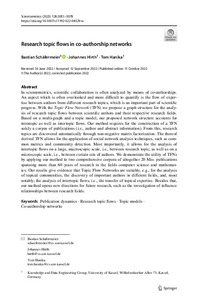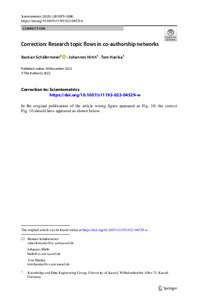| dcterms.abstract | In scientometrics, scientific collaboration is often analyzed by means of co-authorships. An aspect which is often overlooked and more difficult to quantify is the flow of expertise between authors from different research topics, which is an important part of scientific progress. With the Topic Flow Network (TFN) we propose a graph structure for the analysis of research topic flows between scientific authors and their respective research fields. Based on a multi-graph and a topic model, our proposed network structure accounts for intratopic as well as intertopic flows. Our method requires for the construction of a TFN solely a corpus of publications (i.e., author and abstract information). From this, research topics are discovered automatically through non-negative matrix factorization. The thereof derived TFN allows for the application of social network analysis techniques, such as common metrics and community detection. Most importantly, it allows for the analysis of intertopic flows on a large, macroscopic scale, i.e., between research topic, as well as on a microscopic scale, i.e., between certain sets of authors. We demonstrate the utility of TFNs by applying our method to two comprehensive corpora of altogether 20 Mio. publications spanning more than 60 years of research in the fields computer science and mathematics. Our results give evidence that Topic Flow Networks are suitable, e.g., for the analysis of topical communities, the discovery of important authors in different fields, and, most notably, the analysis of intertopic flows, i.e., the transfer of topical expertise. Besides that, our method opens new directions for future research, such as the investigation of influence relationships between research fields. | eng |



